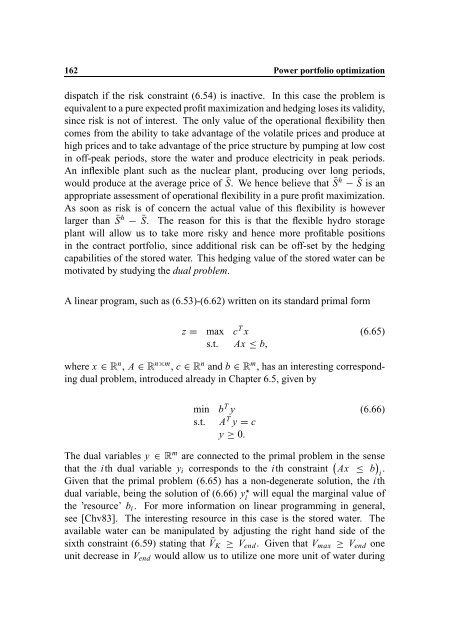Hedging Strategy and Electricity Contract Engineering - IFOR
Hedging Strategy and Electricity Contract Engineering - IFOR
Hedging Strategy and Electricity Contract Engineering - IFOR
You also want an ePaper? Increase the reach of your titles
YUMPU automatically turns print PDFs into web optimized ePapers that Google loves.
162 Power portfolio optimization<br />
dispatch if the risk constraint (6.54) is inactive. In this case the problem is<br />
equivalent to a pure expected profit maximization <strong>and</strong> hedging loses its validity,<br />
since risk is not of interest. The only value of the operational flexibility then<br />
comes from the ability to take advantage of the volatile prices <strong>and</strong> produce at<br />
high prices <strong>and</strong> to take advantage of the price structure by pumping at low cost<br />
in off-peak periods, store the water <strong>and</strong> produce electricity in peak periods.<br />
An inflexible plant such as the nuclear plant, producing over long periods,<br />
would produce at the average price of S. We hence believe that S h S is an<br />
appropriate assessment of operational flexibility in a pure profit maximization.<br />
As soon as risk is of concern the actual value of this flexibility is however<br />
larger than S h S. The reason for this is that the flexible hydro storage<br />
plant will allow us to take more risky <strong>and</strong> hence more profitable positions<br />
in the contract portfolio, since additional risk can be off-set by the hedging<br />
capabilities of the stored water. This hedging value of the stored water can be<br />
motivated by studying the dual problem.<br />
A linear program, such as (6.53)-(6.62) written on its st<strong>and</strong>ard primal form<br />
z max c T x<br />
s.t. Ax b,<br />
(6.65)<br />
where x n , A<br />
n m , c n <strong>and</strong> b m , has an interesting corresponding<br />
dual problem, introduced already in Chapter 6.5, given by<br />
min b T y<br />
s.t. A T y c<br />
y 0.<br />
(6.66)<br />
The dual variables y<br />
m are connected to the primal problem in the sense<br />
that the ith dual variable y i corresponds to the ith constraint Ax b i<br />
.<br />
Given that the primal problem (6.65) has a non-degenerate solution, the ith<br />
dual variable, being the solution of (6.66) yúi<br />
will equal the marginal value of<br />
the ’resource’ b i . For more information on linear programming in general,<br />
see [Chv83]. The interesting resource in this case is the stored water. The<br />
available water can be manipulated by adjusting the right h<strong>and</strong> side of the<br />
sixth constraint (6.59) stating that V K V end . Given that V max V end one<br />
unit decrease in V end would allow us to utilize one more unit of water during
















